|
Section 3. Official Functions
3.1 Organizing the Function
3.1.1 Cultural Issues
3.1.2 Table Seating
Precedence should be the determining factor of seating arrangements for all official functions based on official position or military rank. The place of honor for the male guest is to the right of the hostess. The place of honor for the female guest is to the right of the host. If the guest of honor is given the place of honor at the table, the host should avoid inviting persons of higher rank. The man next in rank sits to the left of the hostess; the next lady, to the left of the host.
Spouses are seated at dinner according to the rank of their husbands or wives, unless they hold official positions themselves.
It is desirable that the total number of persons at the table not be a number divisible by four in order to alternate men and women between the host and hostess. Round tables of six or more persons allow more flexibility than rectangular ones. Two or more tables of six or more persons afford more places of honor, as the host and hostess can each have a co-hostess and co-host at their respective tables.
It is desirable to avoid placing two men and two women next to each other. One should also avoid seating a man and his wife together.
What follows are sample diagram of varied seating arrangements.
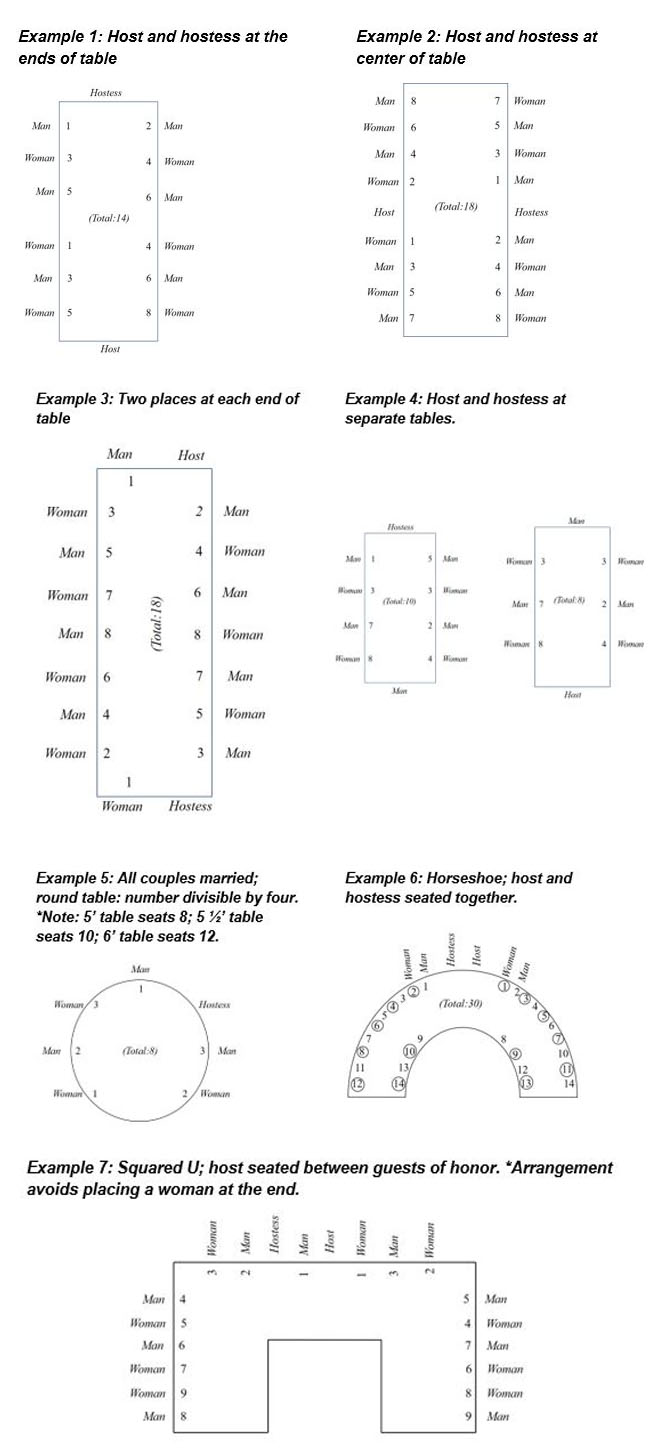
Head Table
Seating arrangements at head tables are required for most public functions such as a charity luncheon a convention dinner, a banquet to honor a distinguished visitor or other prominent person, an event to promote a political cause, etc.
Some functions are stag affairs, some mixed groups, and some are with or without speakers.
For a ladies' luncheon where club officers and important guests comprise the head table, see the example below. A head table at which official and nonranking guests are present is shown below. The important persons who represent their civil and philanthropic organizations may be placed between the official ranking guests after the guest of honor and second top official guest are seated.
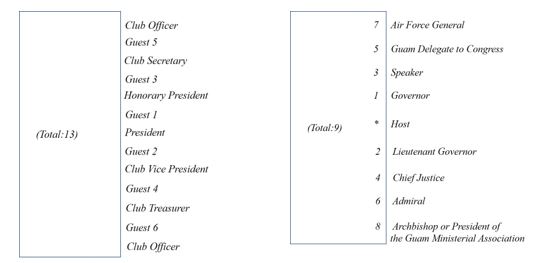
3.1.3 Program
3.1.3a The Fine Art of Toasting
A toast to the guest of honor is expected and is proposed toward the end of the dessert course. Usually the host will tender the toast in tribute to the accomplishments of the guest of honor. At a formal dinner, champagne in one's glass is used to drink the toast At a luncheon, wine is served.
After the brief remarks, the host will ask "Will you stand and join me in a toast to _______?" During the toast, the guest of honor remains seated. After the toast, the guest of honor replies with expressions of gratitude and good wishes.
At the end of the meal, the hostess usually gives the nod to leave the table. Ladies leave the tables first, the senior guests preceding, then the men in the same order.
3.1.3b Blessing of the table
A prayer of thanksgiving for the table will be requested of any clergy person present. Ordinarily, representatives of the Catholic or Protestant communions will be called upon to administer the blessing. When neither a representative from the Archdiocese of Agana or the Guam Ministerial Association is present, a military chaplain (if present) is called to administer the blessing.
Sample Banquet Program
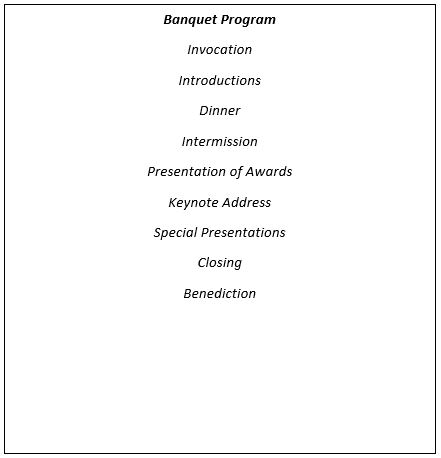
3.1.4 Checklists
When planning any event, a checklist is useful to ensure all tasks are completed and set for the day of the event. Below is a sample checklist for the Hostess:
Event Date
Venue
Event Time
Dress/Attire
Guest list
Invitations; response cards
Program/Setup and Décor
Menu/Caterer Arrangements
Entertainment (if necessary)
Parking (reserved parking for Guest of Honor, if necessary)
Public Address System: microphone
Photographers; Press
Flags
Master of Ceremonies
Staff members
Seating arrangements; place cards
Table numbers
3.2 Protocol for functions
As a courtesy extended to welcome dignitaries, an official dinner, luncheon, or reception is held. Entertaining visiting dignitaries makes them feel welcome and fosters better relationships among public officials.
Official dinners and luncheons are the more formal types of entertainment. On Guam, the reception seems to be the most popular form of entertainment. The reception is generally less formal and more relaxed.
Although Government House usually serves as the hub of official entertainment, other places are also utilized.
Once the date, place, and time are set, the guest list must be prepared, including the seating of guests based on protocol, in case of a formal dinner.
Invitations are sent in advance to officials and individuals for the event. A menu is selected and proper decorations are chosen. Entertainment is usually always planned for the guests.
When seating is arranged, name cards should be placed on the tables. At the table, a guest should wait for the host of hostess to give the signal just when to smoke. In the event they don't smoke, smoking should be delayed until the end of the salad course.
3.2.1 Invitations
Official events are either formal or informal occasions. All invitations include the nature of the occasion, day, date, hour, place and attire.
All formal invitations and replies to them may be fully engraved, partially engraved or handwritten, preferably in black ink. The invitations should be on a plain white card or on a card, any shade associated with white, such as off-white or ivory. The invitations should measure approximately 5 ¼" x 4 ½" or 7 ¼" x 4 ¾". Script and shaded antique Roman letterings are preferred over other types.
Official invitations may bear the seal of the office or the Guam seal. In the military, a replica of a flag officer's personal flag may be used. Envelopes for all invitations should be handwritten in black ink and addressed with the full name of the husband and wife, unless the guest is single.
Invitations should be sent out at least three to four weeks in advance of the date of the event. However, telephone invitations and replies are proper when time does not allow for a written response to be made.
Replies are handwritten in the same form and wording as the invitation. When an acceptance is made, the reply should specify the day and hour and should read "accept with pleasure the kind invitation of." When writing a regret to an invitation, it is a courtesy to give a courteous reason.
Also, in the case of large receptions, it is recommended that the guest list be well-balanced with government officials, the press, personal friends of the host, persons distinguished in scholarly pursuits, persons in business and industry, and persons with similar interests as the guest of honor, if there is one.
If a reply is preferred, the invitation should include an R.S.V.P. Although these letters stand for the French phrase, Réspondez s'il vous plait, which means "Respond if you please," they really convey a much stronger meaning. R.S.V.P. means that a response is expected! When written alone, as shown above, this indicates that the hostess wants the response in writing. The response may be made in a variety of ways; it need not conform exactly to the invitation. For example, if the invitation is written by hand and informal, the response may be on a personal note card, or small sheet of stationery. Even if each line on an informal invitation is centered on the page, the response should not follow that format. See the examples provided on the next page.
Address the written response to an informal invitation to the hostess only, even though the invitation may have come from a couple. (This is the opposite from how a response to a formal invitation is addressed.)
"R.S.V.P." (Phone Number)
This implies that the hostess wants one's response made by telephone. In one's busy life, this is the most expedient method of obtaining responses for written informal invitations.
*Regrets, or Regrets Only
This means that one must respond only if one cannot accept the invitation. It is a reverse approach to most response requests; the hostess hopes to learn which guests will attend by hearing only from those who will not attend. Though the use of "Regrets" is not recommended, if the hostess requests it, follow her instructions. If a phone number is given, one may call to regret. Otherwise, a written regret is expected if one cannot attend.
*Blank Lower Left Corner
When no mention of a response appears on the invitation, then none is expected. One may attend if one is free, or not attend if one has a previous commitment or would prefer not to; it's that simple. However, the next time one sees the hostess. It is polite to thank her for the invitation, and indicate whether or not one will be able to attend.
Oral Invitations
Oral invitations differ from written informal invitations in that one is expected to respond immediately. Many hostesses prefer this method of extending invitations for small gatherings. When an oral invitation is received, and one is free to attend, accept immediately and with enthusiasm. Record all of the particulars one will need to know; host, day, time, place, dress, and type of party.
If one is not free to accept, one should briefly explain why. Even saying one is "not free" is more polite than brusquely saying one "can't come."
Sample RSVPs:

When to respond
Whether responding in writing or by phone, one's response must be prompt - within 24 to 48 hours. If a response is made any longer than the anticipated time, several unfortunate things happen.
Also, the hostess worries that the recipient didn't receive the invitation. Then, she may feel that the recipient was not pleased to have been invited.
Also, one's manners are questioned for not answering her invitation. None of these is desirable and certainly not designed to make a good impression. To start things off right, answer every invitation within 24 to 48 hours.
Guests need to remember that an invitation is issued from a desire to offer hospitality and to please.
Oral Responses
When an oral response to an invitation is appropriate, always make it over the telephone rather than in person. First, the hostess usually has a list of invited guests near her phone; if one calls, she can immediately record one's response. The other reason for phoning is to keep conversations private, so no one can overhear and get their feelings hurt for not having been invited.
3.2.2 Dress Definitions
DRESS DEFINITIONS REFERENCE CHART
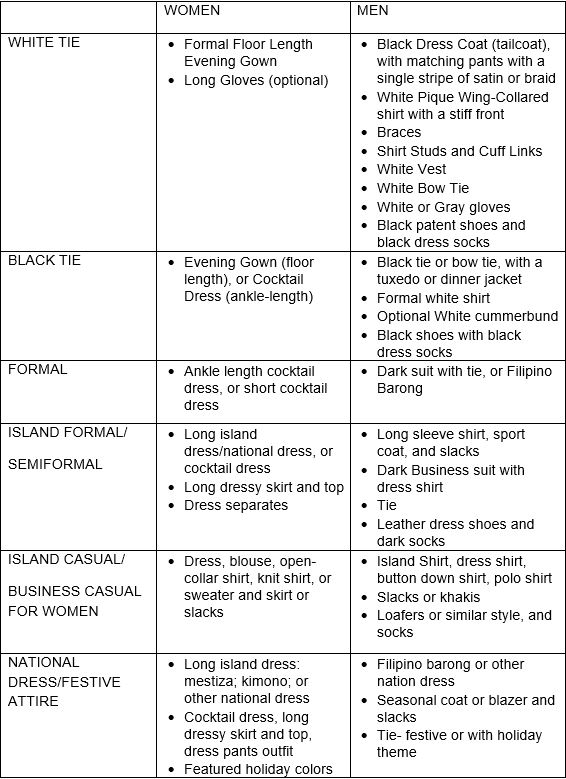
MILITARY EVENT ATTIRE
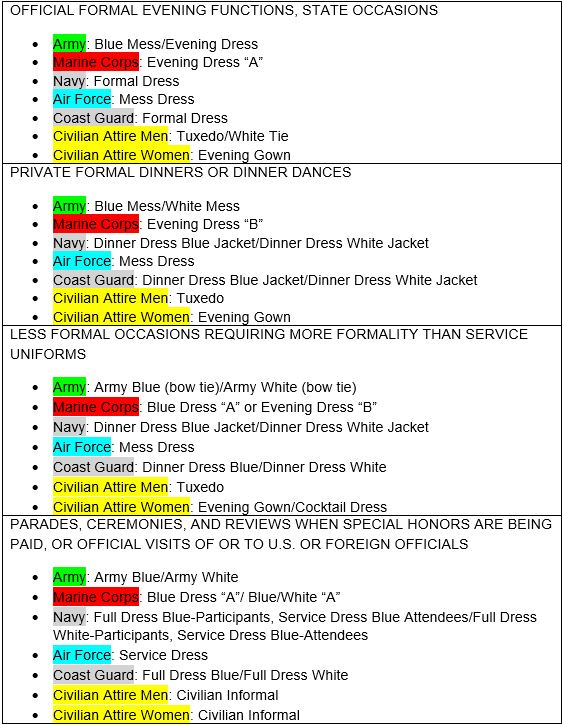
|
|
